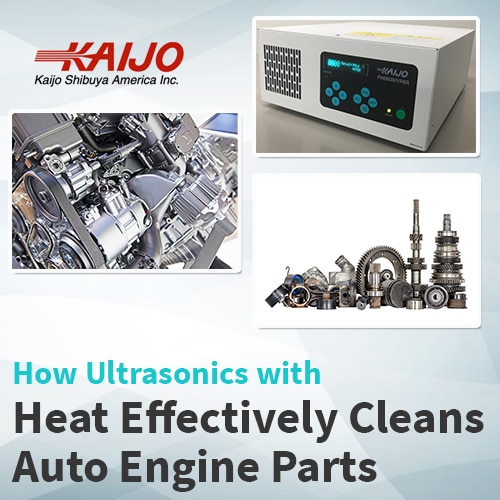How Ultrasonics with Heat Effectively Cleans Auto Engine Parts
December 7, 2021
 When used auto engine parts are heavily contaminated with carbon deposits, oil residue, and hardened grease, they have to be cleaned before they can be installed in re-built engines or used in repairs or classic cars. Traditional cleaning methods rely on soaking in solvents or chemicals, pressure washing for surface dirt, and manual scrubbing for hard-to-reach places. Ultrasonic cleaning doesn’t require chemicals and delivers consistent and effective removal of contaminants without needing manual cleaning for spots that previous cleaning steps have missed.
When used auto engine parts are heavily contaminated with carbon deposits, oil residue, and hardened grease, they have to be cleaned before they can be installed in re-built engines or used in repairs or classic cars. Traditional cleaning methods rely on soaking in solvents or chemicals, pressure washing for surface dirt, and manual scrubbing for hard-to-reach places. Ultrasonic cleaning doesn’t require chemicals and delivers consistent and effective removal of contaminants without needing manual cleaning for spots that previous cleaning steps have missed.
Because ultrasonic systems clean safely and completely without damaging the underlying surfaces, ultrasonic cleaners can lower operating costs, reduce workplace accidents and provide parts that are cleaner than with traditional methods. When used with a heated cleaning solution and mild detergents, automotive ultrasonic cleaning systems work quickly to remove the heat-softened deposits. Ultrasonic cleaning of automotive parts is an attractive alternative to conventional cleaning methods, requiring less labor for improved results.
Heating the Cleaning Solution Improves Ultrasonic Cleaning Performance
Ultrasonic parts cleaners can work with plain water at room temperature, but cleaning takes place more quickly if oily and greasy parts are placed in a heated cleaning bath. Ultrasonic systems work by generating microscopic cavitation bubbles in the cleaning solution. The bubbles produce a scrubbing action that removes contaminants from part surfaces. If hardened grease and oily deposits are heated, the bubbles can remove the softened material more quickly and completely. Adding a mild detergent also helps the bubbles break up the deposits so they can be removed.
Sometimes a specific detergent is chosen because it works best for a known contaminant. At the same time, if the cleaning bath is to be heated, the system components such as the ultrasonic transducers immersed in the bath have to be designed to withstand the higher temperatures. An experienced manufacturer of automotive ultrasonic cleaning systems can help with the choice of detergent and make sure the system supports operation with a heated cleaning bath.
Ultrasonic Cleaners Can Improve Cleaning Performance for All Kinds of Metal Parts
Automotive engine components and other metal parts present varying degrees of difficulty when it comes to cleaning them before installation. Used parts can have surfaces caked with hard deposits while new parts may be contaminated with manufacturing residue or shop dirt. Some parts, such as brake pads or rotors, don’t have to be completely clean but others, such as automatic transmission gears and bearings, have to be free of dirt that may cause eventual failure.
Soaking parts uses expensive chemicals and solvents while taking up a lot of time. Pressure washing and manual cleaning can be effective but are labor-intensive and time-consuming. Automotive ultrasonic cleaning works quickly and without supervision. Operators simply place the parts into the bath, set a timer, and go on to do other work. When they come back, they can remove completely clean parts from the cleaning tank.
While improving the cleaning performance for all kinds of metal parts, ultrasonic cleaners reduce labor costs and costs for the purchase, storage, and disposal of chemicals. When set up with the correct frequency, power, and heating, automotive ultrasonic cleaning systems can be used for almost all cleaning jobs for engine parts.
Kaijo Can Help Automotive Shops Transition to Ultrasonic Cleaning
As a leading manufacturer of ultrasonic cleaning systems, Kaijo can evaluate customer automotive cleaning applications and recommend systems that have the right frequency, power, and heating. For special requirements, Kaijo can customize equipment to meet customer needs. Kaijo offers a complete line of ultrasonic cleaning systems and can ensure the chosen systems meet a customer’s cleaning expectations. Contact Kaijo for a free consultation on selecting the best ultrasonic cleaner for your application.





